Liability in Negligence: Causation Essentials
Concepts of factual and legal causation in negligence, focusing on the but-for test and how it is applied in various scenarios. Real case examples like Barnett v. Chelsea & Kensington Hospital [1969] are discussed to illustrate key principles.
Download Presentation

Please find below an Image/Link to download the presentation.
The content on the website is provided AS IS for your information and personal use only. It may not be sold, licensed, or shared on other websites without obtaining consent from the author.If you encounter any issues during the download, it is possible that the publisher has removed the file from their server.
You are allowed to download the files provided on this website for personal or commercial use, subject to the condition that they are used lawfully. All files are the property of their respective owners.
The content on the website is provided AS IS for your information and personal use only. It may not be sold, licensed, or shared on other websites without obtaining consent from the author.
E N D
Presentation Transcript
Liability in negligence for injury to people and damage to property Negligence: Causation
Learning Objectives By the end of the session you should be able to: 1. Distinguish between factual causation and legal causation. 2. Explain the but for test. 3. Explain how the but for test is applied to cases involving multiple possible causes of injury or loss. 4. Explain how the but for test is applied to cases involving loss of chance. 5. Explain the effect of an intervening act on the chain of causation.
Factual Causation Some learners get confused between factual causation ( causation in fact ) and legal causation ( causation in law ). Factual causation involves showing the link between the defendant's act or omission and the injury or loss caused. Not all factual causation involves legal causation.
Legal Causation Legal causation refers to when the defendant is legally responsible for the injury or loss. For instance, for the defendant to be liable for an injury it must shown that the reasonable person could foresee the injury occurring.
Factual Causation: The Test The claimant must show a causal link between the defendant s act or omission and the damage caused. The test used to establish the factual cause is sine qua non. Activity: Use a legal dictionary, textbook or multimedia device to find out what sine qua non means.
Sine Qua Non Sine qua non is often referred to as the but for test. In other words, it must be shown that but for the defendant s act or omission the claimant would not have suffered damage or loss. In an examination, it is acceptable to refer to it as the but for test rather than refer to it in Latin.
Barnett v Chelsea & Kensington Hospital [1969] Facts: A man went to hospital but was turned away. He later died of arsenic poisoning. He would not have lived even if a doctor had treated him. Held: the hospital was not liable. The but for test was applied. The failure of the hospital was not the cause of his death.
BonningtonCastings Ltd v Wardlaw [1965] Facts: The claimant became seriously ill after working for many years in dusty conditions in a foundry. There were two types of dust in the foundry, only one of which should have been extracted by law. It could not be proved which type of dust the claimant had inhaled. Held: The defendants were liable because although there were two possible causes of the claimant s illness, together they both materially contributed to his illness.
McGhee v National Coal Board [1973] Facts: The claimant was employed to clean out kilns. No wash facilities were provided by the defendants. The man developed dermatitis as a result of the brick dust clinging to his skin. Medical evidence indicated that sweating would increase the amount of brick dust that clung to the skin. The kilns were often warm while the man worked in them. He would also cycle home where he would sweat even more. Held: the House of Lords found the employer liable for negligence because it had materially increased the risk of injury by not providing wash facilities.
McGhee v National Coal Board [1973] Lord Reid stated that: I think that in cases like this we must take a broader view of causation . He went on to state: From a broad and practical viewpoint I can see no substantial difference between saying that what the defender did materially increased the risk of injury to the pursuer* and saying that what the defender did made a material contribution to his injury. [This was a Scottish case appealed to the House of Lords. * Pursuer is the Scottish equivalent of claimant .] http://www.bailii.org/uk/cases/UKHL/1972/7.html
Fairchild v Glenhaven Funeral Services Ltd [2003] Facts: An employee (deceased) had been exposed to asbestos while working for several different employers. He contracted mesothelioma which is a type of cancer caused by asbestos. It could not be determined which employer was responsible. Held: the House of Lords decided that each of the employers who exposed him to asbestos were liable. Each defendant had materially increased the risk of harm towards the claimant.
Fairchild v Glenhaven Funeral Services Ltd [2003] Lord Bingham stated: I am of opinion that such injustice as may be involved in imposing liability on a duty- breaking employer in these circumstances is heavily outweighed by the injustice of denying redress to a victim. Were the law otherwise, an employer exposing his employee to asbestos dust could obtain complete immunity against mesothelioma claims by employing only those who had previously been exposed to excessive quantities of asbestos dust. Such a result would reflect no credit on the law.
Loss of Chance Cases A loss of chance refers to cases where the defendant s negligence deprived the claimant of the opportunity to avoid a loss. They usually involve medical negligence. For instance, a claimant has an illness from which he has a 70% chance of surviving if it is properly treated. His doctor negligently fails to diagnose the illness until the claimant s chance of survival has been reduced to 50%.
Loss of Chance Cases Use a textbook or multimedia device to research the following cases involving causation: Hotson v East Berkshire Area Health Authority [1988] http://www.bailii.org/cgi-bin/ Gregg v Scott [2005] https://www.publications.parliament.uk/
Novus Actus Interveniens Activity Use a legal dictionary, textbook or multimedia device to find out the meaning of novusactus interveniens.
Novus Actus Interveniens Answer: A new intervening act
Breaking the Chain of Causation The link between the defendant s act or omission and the injury or loss suffered is often referred to as the chain of causation. An intervening act may break the chain of causation meaning that the defendant is not liable for the injury or loss suffered by the claimant.
Knightley v Johns [1982] Facts: A car driven by Johns had overturned in a tunnel. The senior police officer instructed a constable to ride his motor bicycle to the other side of the tunnel and close the tunnel. The constable was instructed to drive the wrong way through the tunnel. The constable was then involved in a collision with a car coming the other way. The constable was injured and made claims of negligence against the driver of the overturned car, the senior police officer who instructed him to drive the wrong way and the Chief Constable.
Knightley v Johns [1982] It was held by the Court of Appeal that the senior police officer and Chief Constable were liable for negligence but not the driver of the overturned car. The instructions from the senior officer, going through the tunnel on the wrong side and the collision with the oncoming car were a novusactus interveniens that had broken the chain of causation.
Knightley v Johns [1982] Stephenson, L J. stated: The reasonable hypothetical observer would anticipate some human errors, some forms of what might be called folly, perhaps even from trained police officers, and some unusual and unexpected accidents in the course of their rescue duties. But would he anticipate such a result as this from so many errors as these, so many departures from the common sense procedure prescribed by the Standing Orders for just such an emergency as this? http://www.bailii.org/ew/cases/EWCA/Civ/1981/6.html
Baker v Willoughby [1969] Facts: The claimant was knocked down by the defendant's car. As a result of the car accident he sustained a fairly severe injury to his left leg and ankle and as a result had to take a lower paid job. Three years later when the claimant was at work two men came in and shot at him causing serious injuries to his already damaged leg which then had to be amputated.
Baker v Willoughby [1969] It was argued by the defence that the defendant was only responsible for the claimant s losses and injuries occurred up until the defendant was shot in the leg. They suggested that the shooting and subsequent amputation was a novus actus interveniens that ended any responsibility for the defendant s losses occurred after the amputation. The House of Lords disagreed and held that the claimant s loss of earnings were a result of the original injury.
Baker v Willoughby [1969] Lord Reid stated: Suppose that the Plaintiff has to spend a month in bed before the trial because of some illness unconnected with the original injury, the Defendant cannot say that he does not have to pay anything in respect of that month: during that month the original injuries and the new illness are concurrent causes of his inability to work and that does not reduce the damages. http://www.bailii.org/uk/cases/UKHL/1969/8.html
Jobling v Associated Dairies [1982] Facts: the claimant slipped at work due to his employer's negligence and injured his back which reduced his earning capacity. Three years later he developed a spinal disease that was unrelated to the earlier accident. Held: the House of Lords decided that the spinal disease was a novusactus interveniens and the employer was not responsible for losses incurred after the disease occurred.
Jobling v Associated Dairies [1982] The House of Lords was critical of its earlier decision in Baker v Willoughby [1969] although they did not depart from it. Lord Bridge stated: Having reached the conclusion that the ratio decidendiof Baker's case cannot be sustained, it remains to consider whether the case should still be regarded as authority . http://www.bailii.org/uk/cases/UKHL/1981/3.html
McKewv Holland & Hannen& Cubitts(Scotland) Ltd [1969] Facts: The claimant suffered a leg injury as a result of his employer s negligence which left his leg seriously weakened. He later fell when he tried to come down a steep flight of stairs with no handrail. Held: The House of Lords decided that the defendant s were not liable for the second injury because his decision to come down stairs without a hand rail or assistance was a novusactus inteveniens which had broken the chain of causation.
McKewv Holland & Hannen& Cubitts(Scotland) Ltd [1969] Lord Reid stated: [If] the injured man acts unreasonably he cannot hold the defender liable for injury caused by his own unreasonable conduct. His unreasonable conduct is novus actus interveniens. The chain of causation has been broken and what follows must be regarded as caused by his own conduct and not by the defender's fault or the disability caused by it. http://www.bailii.org/uk/cases/UKHL/1969/9.html
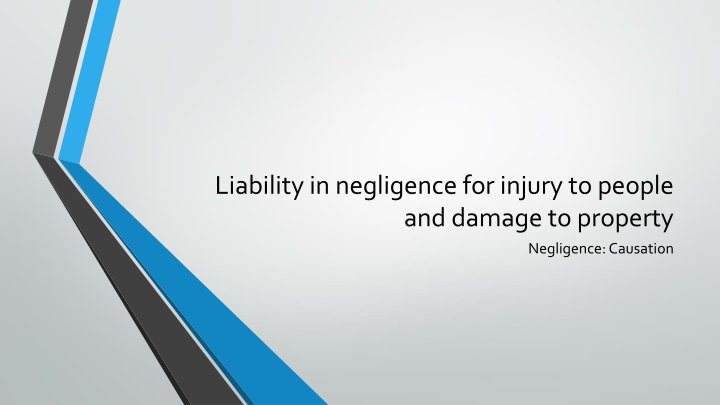

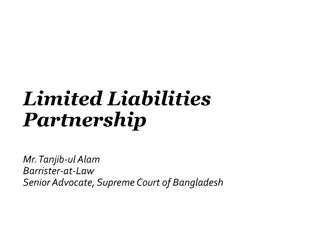
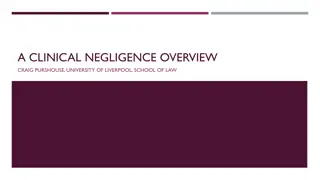
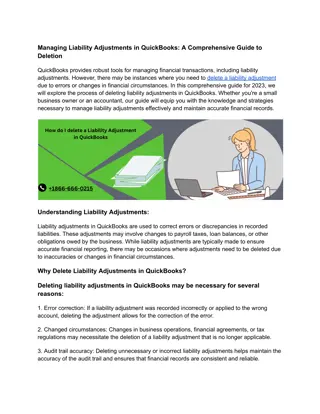
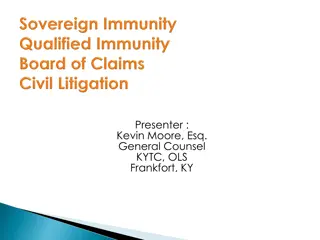
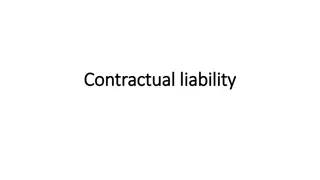
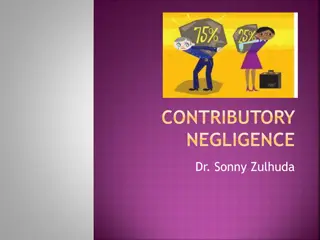
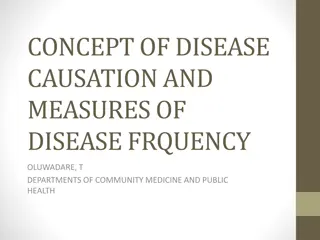
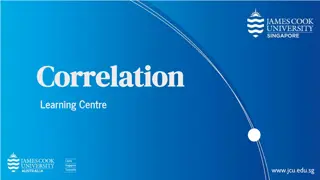
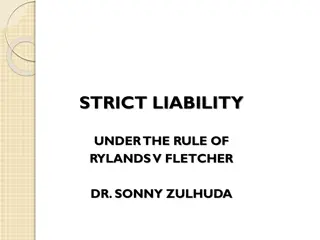
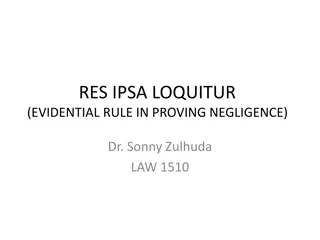

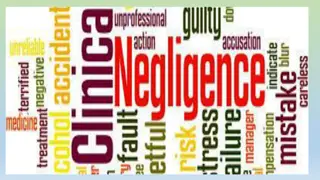

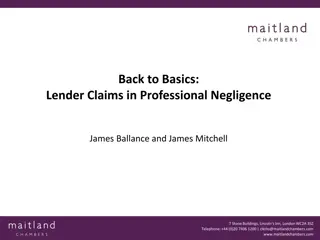





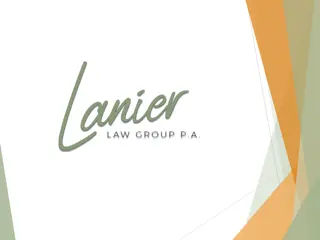
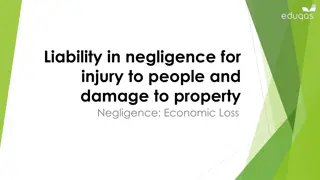
![Negligence Liability in Donoghue v. Stevenson [1932]](/thumb/198881/negligence-liability-in-donoghue-v-stevenson-1932.jpg)